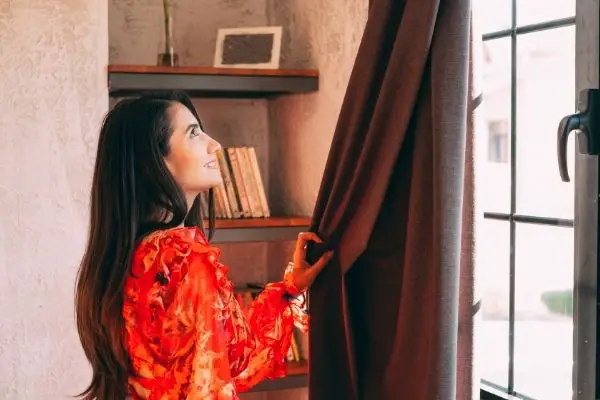Curtains 101: Do Blackout Curtains Keep The Heat Out?
We all know that the sun is hot (duh!). But did you know that standard double-pane windows only block one-quarter of the sun’s heat?
If your home is anything like mine, then those south-facing windows are prime basking spots for household pets. Unfortunately, it’s impossible to ignore the strain those same sunny windows put on the A/C during the summer months.
The more sunlight you can block during the hottest parts of the year, the less energy it’ll take to keep your home interior cool and comfortable. And blackout curtains are some of the best tools for the job.
So, yes, blackout curtains do keep a significant amount of heat out. If you want to learn more about getting the most energy savings from your window treatment, however, keep reading!
Blackout Curtains vs Thermal Curtains: What’s The Difference?

We recently took a detailed look at what makes blackout curtains efficient compared to regular window treatments. But to ensure everyone is on the same page, let’s recap:
When shopping for blackout curtains, there’s a good chance you’ll come across drapes labeled as “thermal curtains” as well. Here’s what makes thermal curtains unique:
You may have noticed that the construction of blackout and thermal curtains sounds very similar.
Both rely on multiple layers — typically at least one of which is made of foam — to block light or heat respectively. Curtain manufacturers have also caught onto these similarities, and many curtains sold today perform both tasks at once.
Which Type Of Curtains Are Right For You?
Because they are so thick, blackout curtains will naturally block some heat. And, since the porous fabric isn’t great for insulation, thermal curtains will block a good bit of light. For some households, these crossover benefits are enough.
If you want to enjoy excellent light-blocking and insulation at the same time, we recommend investing in a set of curtains that promises to do both.
Will Blackout Curtains Keep The Cold Out?
Yes. Since sunlight and heat go hand in hand, the connection between blackout curtains and summer energy savings is fairly obvious. That begs the question… Can blackout curtains help insulate your home against cold winter air as well?
Yes!
According to the US Environmental Protection Agency, approximately 30% of heat leaves the home via windows. Put bluntly, that means 30% of the energy used to heat your home in winter could be going to waste.

Blackout curtains’ light-blocking abilities will not stop heat from leaving your home. But the thick, multi-layered material will.
Blackout curtains trap air between the fabric and window panes (all curtains do this to an extent but blackout and thermal curtains work particularly well). This pocket of air creates a cushion between the warm air indoors and the cold air outside, drastically slowing down the transfer of heat.
3 Ways To Optimize Your Blackout Curtains In Winter
Investing in high-quality thermal blackout curtains is an awesome first step! If you’re looking to go above and behind in your energy-saving efforts this winter, try out these tips:
- Open blackout curtains on bright, sunny days to let the sun’s natural heat filter through your windows. Keep curtains closed on overcast days and at night.
- It might be counterintuitive but consider hanging your heaviest thermal blackout curtains on windows that do not receive regular sunlight. You’ll block the unwanted transfer of heat without losing out on the sun’s warmth during the day.
- Opt for curtains with a dark window-facing liner to absorb as much heat from the sun as possible. This heat will then dissipate throughout the room. Alternatively, you can hang a thin dark-colored curtain behind your light-colored blackout or thermal curtains during winter and take it down during summer.
How Much Energy Can Blackout Curtains Save?

We’d love to shock and awe you with exactly how much energy (and money!) you’ll save by switching to blackout window treatments. Sadly, there are just too many factors to take into consideration to make that possible.
We can, however, give you some impressive estimates!
A study in Britain found that closing standard drapes at night reduces heat loss by 15-17%. Meanwhile, it’s estimated that blackout curtains reduce heat loss by approximately 25%.
If your home is currently losing 30% of its heat through your windows, that equals energy savings of up to 7.5%. That could make a huge difference in your energy bill and household sustainability!
Of course, you don’t need to achieve maximum savings to make switching to blackout curtains worth it. Even energy savings of 1% could have a big impact on your wallet and carbon footprint.
Frequently Asked Questions
Will blackout curtains block outside noise?
Blackout curtains can and do block noise coming from outside your windows — the thicker the materials the better. But most blackout curtains aren’t optimized for this purpose.
If limiting outside noise is your top priority, then you’ll want to look into a product called a soundproofing curtain.
There’s good news, however! Just like the similarities of blackout and thermal curtains, there’s a lot of overlap between blocking noise and blocking light. So many (if not most) soundproofing curtains also block out unwanted light and offer thermal insulation.
Which color of blackout curtain is best?
In the past, blackout curtains were almost exclusively available in dark colors. That’s no longer the case.
If you’re wondering about the role color plays in your curtains’ capacity for heat-blocking, keep in mind that nearly all blackout curtains feature a white window-facing liner. This white liner will reflect much of the sun’s rays (up to 33% by some estimates), even if the fabric inside your home is a dark color.





